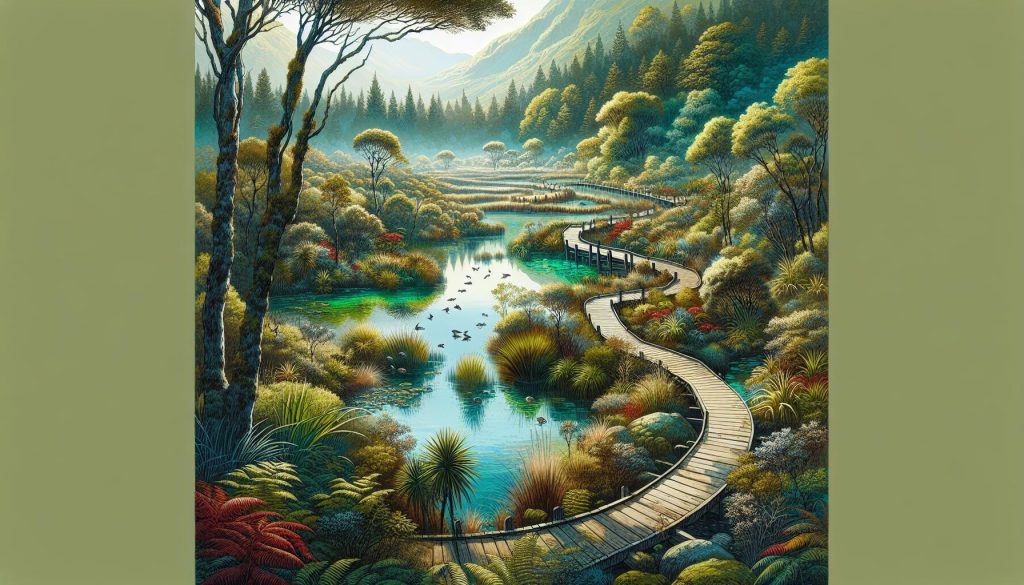If you’re anything like me, you find yourself constantly drawn to the raw beauty of nature. That’s exactly what led me to Wakodahatchee Wetlands in Delray Beach. It’s a hidden gem for nature lovers, offering an escape into a world teeming with wildlife and lush scenery.
Wakodahatchee Wetlands isn’t just another park; it’s a vibrant ecosystem that invites visitors to step into the shoes of an explorer. With its boardwalk winding through the preserve, I’ve had countless unforgettable encounters with birds, turtles, and even alligators! It’s a place where every visit feels like a new adventure.
Discovering Wakodahatchee Wetlands
I’d heard whispers of Wakodahatchee Wetlands for years before I finally decided to see it for myself. Nestled in Delray Beach, this hidden gem promised an immersive nature experience that I simply couldn’t resist. I’ve always been drawn to the tranquility and undeniable beauty of natural settings, and Wakodahatchee seemed like it would deliver just that. So, one sunny morning, armed with my camera and a sense of adventure, I set out to explore.
Walking into Wakodahatchee, I was immediately struck by the sheer serenity of the place. The sound of city life faded away, replaced by the gentle sounds of water and whispers of wind through the grasses and reeds. The wetlands are designed around a 3/4 mile-long boardwalk, which meanders through a variety of ecosystems, each hosting its unique inhabitants. From the very first steps, I was captivated.
The variety of wildlife I encountered was astounding. Everywhere I looked, there was something new to see. Here’s a quick glimpse at the diversity:
- Birds: From majestic herons to vibrant painted buntings, the array of birdlife was impressive. I lost count of the different species I spotted.
- Reptiles: Sunning turtles dotted the banks, and the occasional alligator could be seen lurking in the waters.
- Amphibians and Fish: The chorus of frogs was a constant background music, and flashes of fish could be caught in the clear waters below.
Every turn of the boardwalk presented a new scene, a new interaction in the thriving ecosystem of Wakodahatchee. I found myself captivated by the simplicity of a turtle basking in the sun or a family of ducks paddling through the water.
What’s more, the wetlands are not just a place of beauty; they’re a vital part of the environment. Wakodahatchee Wetlands serve as a natural water filtration system, cleaning millions of gallons of water before returning it to the Everglades. It’s an incredible example of how nature can work hand in hand with human-engineered solutions to benefit the environment.
Rich Biodiversity at Wakodahatchee Wetlands
Walking through Wakodahatchee Wetlands, it becomes clear why nature enthusiasts and wildlife photographers find this place irresistible. It’s not just the peaceful scenery that captures the heart but the incredible diversity of life that thrives here. I’ve been lucky to observe and learn about the myriad of species calling this wetland their home, and it’s an experience I’m eager to share.
The wetlands are a vibrant tapestry of ecosystems, each contributing to the area’s ecological wealth. On my visits, over 178 bird species have been identified, some of which are rare and exotic, bringing birdwatchers from all over. It’s not uncommon to spot the majestic Great Blue Heron standing still as a statue, waiting for its next meal, or to hear the distinct call of the Purple Gallinule echoing through the reeds.
| Species Group | Number of Species |
|---|---|
| Birds | 178+ |
| Reptiles | 50+ |
| Amphibians | 20+ |
| Mammals | 30+ |
But birds are just the beginning. The wetlands also offer shelter to an impressive variety of reptiles. From the common sight of turtles basking in the sun to the occasional thrill of spotting an alligator, it’s a herpetologist’s dream. And let’s not forget the smaller inhabitants, such as frogs and fish, which play crucial roles in the wetland’s food web.
One of the most fascinating aspects of exploring Wakodahatchee is witnessing the delicate balance of this ecosystem. Each species, no matter how small, has a role to play. This balance ensures the health and sustainability of the wetlands, demonstrating nature’s incredible resilience and intricacy.
In my strolls along the boardwalk, I’ve also encountered various mammals. From the playful river otters to the shy raccoons, each sighting is a reminder of the land’s wild essence. It’s these unexpected encounters that make each visit uniquely memorable.
Exploring the Boardwalk
One of the most mesmerizing experiences at Wakodahatchee Wetlands is undoubtedly walking along its famous boardwalk. The moment I stepped onto the wooden path, I was immediately enveloped in the natural beauty that sprawls as far as the eye can see. The boardwalk, which stretches for nearly a mile, offers an intimate glimpse into the abundant wildlife and ecosystems thriving in the wetlands. It’s an adventure that beckons nature lovers like myself to delve deeper into the wonders of this preserved area, forging a connection with the environment that’s both profound and educational.
As I meandered along the boardwalk, the sounds of nature filled the air. Bird calls echoed, creating a symphony that changed with the time of day. Morning treks were often greeted with the melodious songs of waking birds, while dusk brought the mystical sounds of nocturnal creatures beginning their nightly routines. Every step brought a new discovery, from spotting a Great Blue Heron elegantly wading in the water searching for its next meal, to glimpsing a family of turtles basking in the sun.
Photography enthusiasts and bird watchers would find the boardwalk a haven, with countless moments worth capturing. The design of the boardwalk, with its strategically placed viewing platforms, allows visitors to stop, observe, and photograph the wildlife without disturbing their natural habitat. I found myself frequently pausing, camera in hand, waiting for the perfect moment to snap a picture that spoke to the beauty and diversity of Wakodahatchee Wetlands.
For families visiting, the boardwalk provides an accessible and safe way to introduce children to the importance of conservation and the roles different species play in the ecosystem. Informational signs dotted along the path offer valuable insights into the flora and fauna, making the walk both an educational and entertaining experience. My interactions with fellow walkers often included sharing sightings and tips on where to spot the elusive wildlife, creating a sense of community among nature lovers.
The blend of accessibility, education, and the sheer beauty of untouched nature makes the boardwalk at Wakodahatchee Wetlands a must-visit for anyone looking to immerse themselves in the natural world. Each visit feels unique, offering new sights, sounds, and experiences. Whether you’re a seasoned birder, a photographer looking for that perfect shot, or a family eager to explore the wonders of nature together, the boardwalk serves as a gateway to the extraordinary biodiversity of the wetlands.
Wildlife Encounters
At Wakodahatchee Wetlands in Delray Beach, I’ve had some of the most memorable wildlife encounters that nature lovers like me dream of. The variety of species living in harmony within this preserve is nothing short of spectacular. Walking along the boardwalk, every step brings a new discovery, a new moment to cherish.
One of the first creatures that greeted me was the Great Blue Heron, standing statuesque in the shallow waters. These majestic birds are a common sight here, yet their graceful hunting dance never ceases to amaze. It’s a sight you’ll want to capture, so keeping your camera ready is a must. But the herons are just the beginning. The wetlands are teeming with life, from the vibrant pink feathers of the Roseate Spoonbills to the stealthy glide of the American Alligators beneath the water’s surface. The diversity is astounding.
| Species | Frequency of Sightings |
|---|---|
| Great Blue Heron | Common |
| Roseate Spoonbill | Frequent |
| American Alligator | Occasionally |
| Anhinga | Often |
| Green Heron | Regular |
Each of these species contributes to the unique ecosystem of Wakodahatchee Wetlands, making every visit a learning experience. The Anhingas, with their distinctive swimming style, often mistaken for snakes, are a fascinating lesson in adaptation. Meanwhile, the Green Herons showcase intelligence by using tools to fish, demonstrating nature’s ingenuity.
For those of us keen on bird watching, the wetlands don’t disappoint. The marshes serve as a crucial resting and feeding ground for migrating birds, making every season a potential for rare and exciting sightings. The air is filled with songs and calls, a symphony composed by nature itself. This auditory experience, paired with the visual spectacle, creates a serene, almost surreal atmosphere that’s hard to find elsewhere.
Preserving Nature at Wakodahatchee Wetlands
When I first set foot in Wakodahatchee Wetlands, I’m immediately struck by the sheer dedication to preserving nature in its most pristine form. It’s not just about keeping the area looking beautiful; it’s about ensuring that the ecosystem thrives, supporting a wide range of wildlife that calls this wetland home. The efforts to maintain and restore the natural habitats here are truly commendable, mirroring a commitment to conservation that we can all learn from.
One of the key initiatives I’ve observed is the management of invasive species. These unwelcome guests can wreak havoc on the local flora and fauna, disrupting the ecological balance. Through careful monitoring and management, the preserve ensures that native species get the upper hand, maintaining the ecological harmony that’s so vital for the wetlands’ health. This delicate balancing act is a cornerstone of the conservation efforts here, requiring not just expertise but a deep respect for nature’s intricacies.
Education and community involvement form another critical aspect of the conservation strategy. By engaging the public through guided tours, educational programs, and volunteering opportunities, there’s a collective effort to foster a deeper understanding and appreciation of the wetlands’ ecological importance. I’ve noticed that visitors, myself included, come away with a heightened awareness of the challenges facing such ecosystems and a renewed commitment to environmental stewardship.
Habitat restoration projects abound, aimed at reversing the damage caused by human activity and natural erosion. These projects not only improve the quality of the water but also enhance the habitat for the numerous bird species, reptiles, and mammals that depend on this ecosystem for survival. Whether it’s planting native vegetation or building structures to prevent erosion, every action taken is a step towards a healthier wetland environment.
Monitoring water quality is an ongoing priority, crucial for the well-being of the wetlands’ inhabitants. The balance of fresh and salt water, the pH levels, and the presence of pollutants are all carefully tracked to ensure the waters remain a safe haven for wildlife. It’s a complex, ongoing challenge that demands constant vigilance, but the results speak for themselves in the thriving populations of species that I’ve been fortunate enough to witness here.
Conclusion
Visiting Wakodahatchee Wetlands in Delray Beach is more than just a day out in nature. It’s a firsthand look at conservation in action and a testament to the dedication of those working tirelessly to protect our planet’s precious ecosystems. Whether you’re a bird watcher, a photography enthusiast, or simply someone who loves to bask in the beauty of the natural world, this place has something special for you. Let’s not forget the role we play in supporting these efforts through awareness and responsible tourism. I can’t wait to go back and see what new wonders await.
Harlan Kilstein the publisher of this website is a resident of Delray. He has lived in Palm Beach County since 1997, In that time he has explored everything for surfing on private beaches in Delray to walks up and down Atlantic Avenue.
He is known to drop everything at a moment's notice to fish in Delray Lakes, bird watch, goes horseback riding or play pinball at the Delray Pin Ball Museum.
You can find him either sipping a coffee on Atlantic Avenue or drinking a flight of whiskey at Warren's.
One thing is certain, he knows Delray Beach.



